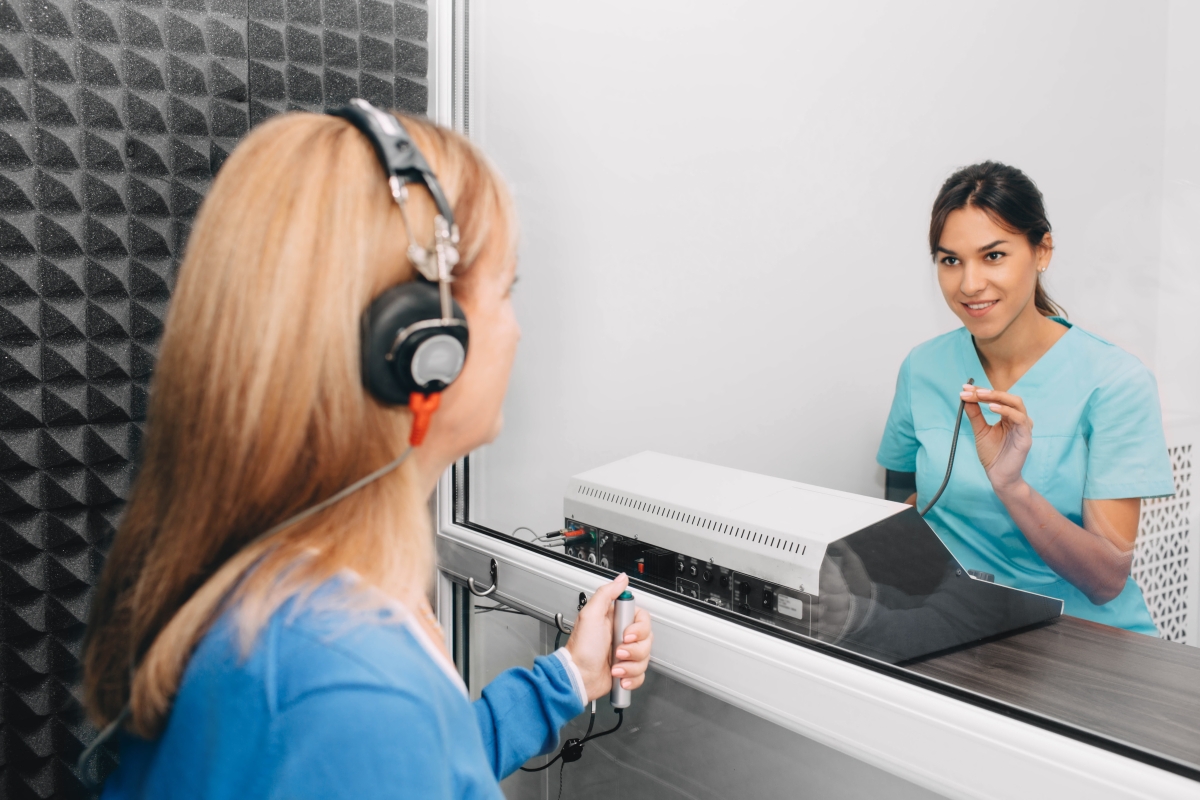Career Overview
Audiologists and speech-language pathologists help people with hearing and communication disorders. Audiologists work with clients who have hearing loss, balance problems and tinnitus – also known as ringing in the ear. Speech-language pathologists work with clients who have challenges with speech, fluency, language, voice and swallowing.
Job Titles
Duties
Audiologists:
- Use special instruments, electronic equipment, tests and examinations to diagnose and measure hearing impairment
- Develop and carry out care plans for clients to attain or regain skills, such as lip reading
- Teach clients how to use assistive listening devices, such as hearing loops
- Talk to clients and families about the nature and impact of hearing loss and treatment
- Work on teams with other health-care professionals to set personalized care plans
- Educate other professionals and groups on preventing hearing loss, giving screening tests and promoting noise reduction
- Carry out research on hearing disorders and on the development and design of diagnostic procedures/devices
They may also teach and supervise audiometric technicians, students and other health-care workers. Audiologists who are registered as hearing instrument practitioners can select, fit and adjust amplification devices, such as hearing aids. Also, audiologists with special certification can work with clients with cochlear implants and balance disorders.
Speech-language pathologists:
- Observe clients and use tests and examinations to diagnose and measure delays and disorders
- Develop and carry out plans to deal with speech, voice, language, feeding and swallowing issues
- Talk to clients and families about the nature and impact of their disorders and treatments
- Work on teams with other health-care professionals to set group and personalized care plans
- Carry out research on speech and communication disorders and on the development and design of diagnostic procedures/devices
- Use tools, ranging from books and toys to linguistic analysis software, sophisticated sound analyzers and electronic communication devices
- Advocate for children and adults with language impairments by promoting early education programs and improved services for clients of all ages
They may also teach and supervise communicative health assistants, students and other health-care workers.
Earnings
Earnings is income that workers receive in exchange for their labour. Depending on the type of employment, earnings can be in the form of wages (hourly), salaries (fixed monthly or annual) or self-employed earnings.
Work Environment
# Workers Employed
1,475% Employed Full Time
47%Audiologists and speech-language pathologists work in hospitals, schools, community and public health centres, long-term care facilities, clinics, rehab centres, pediatric centres, colleges, universities, government agencies and research labs. Some may work in private practice.
Some audiologists and speech-language pathologists provide home health care, which requires daily travel. Others move between multiple work sites, such as long-term care facilities. Some audiologists and speech-language pathologists offer virtual care. Audiologists often spend time in soundproof booths.
Full-time professionals generally work a 36-hour week. This may include evenings and weekends to meet clients’ needs.
Job satisfaction among audiologists and speech-language pathologists is generally high. Many enjoy the variety, challenge and independence of the work. Members of both professions tend to stay in their fields for many years.
Career Pathways
With experience and training, audiologists and speech-language pathologists may advance into teaching, supervisory, management or administrative positions.
Both audiologists and speech-language pathologists can choose to practise in specific treatment areas or with certain age groups. They can also consult or focus on research.
Occupational Interests
It’s important to understand what kinds of occupations align with your interests.
For more about occupational interests visit Skills for the Future Workforce > Characteristics.
Here are the top occupational interest(s) for this career profile:
Education, Training and Skills
Audiologists must have a master’s degree in audiology. Speech-language pathologists need a master’s degree in speech-language pathology. In addition, both audiologists and speech-language pathologists are regulated health professionals and must be certified by the College of Speech and Hearing Health Professionals of BC.
To dispense hearing aids, an audiologist must also be registered as a hearing instrument practitioner. An individual does not have to be an audiologist, however, to become registered as a hearing instrument practitioner. Audiologists may need additional certifications to work with clients with cochlear implants, balance disorders and other complex issues.
Workers coming to B.C.
Audiologists and speech-language pathologists who are certified by a regulator elsewhere in Canada can apply for the same certification from the regulator in B.C. Under the terms of the Canadian Free Trade Agreement (CFTA), most applicants who are transferring their credentials from elsewhere in Canada will not be required to complete additional training or testing. However, the B.C. regulator may ask applicants to provide further information, such as a letter of good standing, references or a criminal record check.
Workers who trained outside of Canada
Audiologists and speech-language pathologists who trained outside of Canada and have never received certification from a Canadian jurisdiction will likely need a full assessment. Most occupational regulators have a process for assessment and recognize internationally trained applicants. Contact the College of Speech and Hearing Health Professionals of BC for details on how to apply for certification in B.C.
For information about labour mobility in Canada, visit www.workersmobility.ca.
View a list of Professional Regulatory Authorities in B.C.
Education programs in B.C.

Top Skills
Every job calls for a certain set of skills. Knowing those skills is the first step in finding a good career fit.
Here, you will find the 10 most relevant workplace skills. Some are more important to achieving success in a certain career than others. These skills may come naturally to you or you may need to gain them through education, training and experience.
See the list of work-related skills below, ranked in order of importance for this career. Check out the list and see if this career matches your skills—take that first step!
Understanding written sentences and paragraphs in work-related documents.
Giving full attention to what other people are saying, taking time to understand the points being made, asking questions as appropriate, and not interrupting at inappropriate times.
Being aware of others’ reactions and understanding why they react as they do.
Using logic and reasoning to identify the strengths and weaknesses of alternative solutions, conclusions or approaches to problems.
Talking to others to share information effectively.
Communicating effectively in writing as appropriate for the needs of the audience.
Understanding how new information could be used to solve current and future problems in making decisions.
Keeping track of and assessing your performance, other individuals, or organizations to make improvements or take corrective action.
Considering the relative costs and benefits of potential actions to choose the most appropriate one.
Being able to solve novel, ill-defined problems in complex, real-world settings.
Labour Market Statistics
Discover data, facts and information that have been gathered and analyzed. Learn about the characteristics of the economy and labour market in B.C.
Employment
Find out about employment types and trends by region and industry.
Employment
1,475Employment by Region







| Region | Employment | % Employment of this Occupation |
|---|---|---|
| Cariboo | 65 | 4.4% |
| Kootenay | 50 | 3.4% |
| Mainland/Southwest | 855 | 58.2% |
| North Coast and Nechako | 20 | 1.4% |
| Northeast | 15 | 1.0% |
| Thompson-Okanagan | 175 | 11.9% |
| Vancouver Island/Coast | 300 | 20.4% |
Labour Market Outlook
The B.C. Labour Market Outlook is a 10-year forecast of the expected supply and demand for labour in the province. It’s usually updated every year. The purpose is to provide British Columbians with the knowledge to make informed decisions on careers, skills training, education and hiring.
Forecasted Job Openings (2025-2035)
760Forecasted Job Openings
Forecasted Employment Growth Rate
Composition of Job Openings
Job Openings by Region (2025-2035)







| Region | Job Openings | Avg. Annual Employment Growth |
|---|---|---|
| Cariboo | 20 | 1.2% |
| Kootenay | 20 | 1.1% |
| Mainland/Southwest | 460 | 1.7% |
| North Coast and Nechako | Not available | Not available |
| Northeast | Not available | Not available |
| Thompson-Okanagan | 100 | 1.6% |
| Vancouver Island/Coast | 170 | 1.7% |
Industry Highlights
Learn about the opportunities in B.C.'s major industries, including employment trends, earning potential, locations of work and more.
Forecasted Job Openings by Industry
| Industry | Job Openings (2025-2035) |
|---|---|
| Health Care and Social Assistance | 640 |
| Educational Services | 110 |
| Retail Trade | 10 |
Insights from Industry
Demand for audiologists and speech-language pathologists is being driven by a growing and aging population, greater public health awareness and new medical technologies and procedures. Also, low numbers of new graduates are contributing to this increased demand.
Audiologists and speech-language pathologists are needed throughout B.C., with the strongest demand in northern and remote areas. Public health audiologists are in especially high demand in the Interior region and in rural and remote areas of the province. To help fill these openings, the B.C. government offers loan forgiveness to audiology and speech-language pathology graduates who commit to working in under-served regions.
The range of services provided by audiologists and speech-language pathologists continues to grow as people live longer and experience more issues. Also, these roles are expanding as more attention is given to job-related hearing disorders and early detection in children. New technologies and treatments also bring changes.
Resources
-
American Speech-Language-Hearing Association (ASHA)www.asha.org
-
Canadian Academy of Audiology (CAA)www.canadianaudiology.ca
-
College of Speech and Hearing Health Professionals of BC (CSHHPBC)cshbc.ca
-
National Centre for Audiology (NCA)www.uwo.ca/nca
-
Speech and Hearing BCspeechandhearingbc.ca
-
Speech-Language and Audiology Canada (SAC)www.sac-oac.ca
-
The University of British Columbia School of Audiology & Speech Scienceswww.audiospeech.ubc.ca








